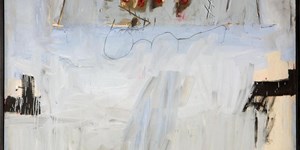
Bozar looks back on the work of Antoni Tàpies (Barcelona, 1923-2012) with a retrospective that travels through time between 1944 and the 1990s.
This is the first major exhibition in Belgium to showcase a complete view on the work of the artist with a selection of 122 works reunited at Bozar for the first time after several decades. From early drawings and self-portraits, the exhibition will unfold with his 'matter paintings' of the 1950s and the objects and assemblages of the 1960s and 1970s. It will continue with his varnishes of the 1980s, which he started a few years earlier coinciding with the beginning of democracy in Spain, and will conclude with works from the 1990s, when Tàpies continued the formal and material experimentation that was always at the heart of his practice.
Obsessed with a variety of themes and objects, Tàpies’ reflection on the problems of painting and representation pervades all his work over the course of the second half of the 20th century. It causes him to cease thinking of painting as a neutral and illusionistic medium, materialising it instead on an opaque surface, nothing less than a wall, on which material, form, language and idea seem indistinguishable, though without annulling their difference. Straddling the objectual, the pictorial and the written, his painting is narrative, tactile and somewhat sculptural.
Art history has associated the work of Tàpies with post-war abstraction and informalism on the basis of its expressionist features. Nevertheless, the unmistakable way in which the artist uses matter to create forms of objects is not classifiable within these tendencies, which characteristically normalised the use of spontaneous and gestural brushwork. Introspection, structural rigour, writing and the vulnerability of the ephemeral form part of a conscientious exploration of the properties of the material that resulted in the use of a sober palette akin to the gradations of earth, honey, lime and wood.

Gran llençol [Great Sheet], 1968 - © Museo Nacional Centro de Arte Reina Sofía, Madrid
Tàpies’s beginnings were marked by the inheritance of the historical avant-gardes and his association with the Dau al Set [Seven-Sided Die] group until the 1950s, when the artist began a prolonged experimentation with matter that launched his career into the international arena. In the 1960s, he engaged in a series of objectual trials, while at the same time his anti-Francoist political commitment became more explicit in his work. The arrival of democracy in Spain, and with it a new cultural reality, coincided with new investigations of matter, the incorporation of varnish and the influence of oriental spirituality. A feeling of nostalgia invades the work of Tàpies in his last two decades. Conscious of his advanced age, the theme of death and sickness becomes dominant.
The title of this exhibition is taken from the first compilation of writings by Tàpies, published in 1970. Organised to mark the centenary of the artist’s birth, it sets up a dialogue among artworks that have long been dispersed, and allows his work and his influence on the recent history of art to be reassessed.
Antoni Tàpies. The Practice of Art, 15 September - 7 January 2024. Curated by Manuel Borja Villel
Image : © Museo Nacional Centro de Arte Reina Sofía, Madrid

ArtDependence Magazine is an international magazine covering all spheres of contemporary art, as well as modern and classical art.
ArtDependence features the latest art news, highlighting interviews with today’s most influential artists, galleries, curators, collectors, fair directors and individuals at the axis of the arts.
The magazine also covers series of articles and reviews on critical art events, new publications and other foremost happenings in the art world.
If you would like to submit events or editorial content to ArtDependence Magazine, please feel free to reach the magazine via the contact page.